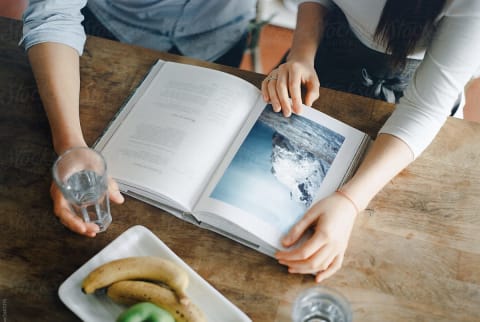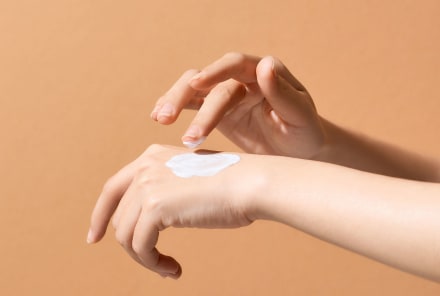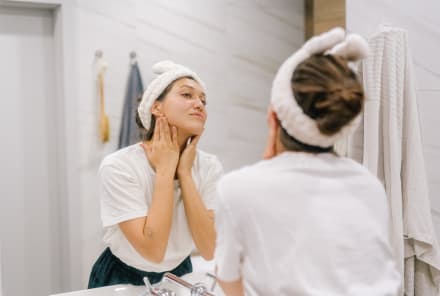Advertisement
I Had No Idea How Much Plastic Waste This One Kitchen Item Saves (It's A LOT!)

The U.N. warned us: We have 12 years before the damage we've done to the Earth becomes irreversible. Instead of letting reports like this paralyze us, let's use them to empower us. The experts are saying it's going to take a mix of large-scale change AND individual action to save our planet—and we want to help you do what you can. Consider our new series your no-excuses guide to cleaning up your act, one step at a time. Today, we're sharing one simple swap that could save 900 bottles from landfills—in just six months.
When I first moved in with my husband, we both had to adjust—a lot. From KonMari-ing two people's worth of stuff to fit in a New York City apartment to combining our finances to figuring out how we were going to divvy up the housework, the give-and-take was expected. (And totally worth it.)
But there was one thing I never thought we'd have to discuss: what kind of water we'd be drinking all day, every day.
When I was single, I always kept a Brita water dispenser in the fridge. But once I moved into our new home, I was suddenly tripping over cases of bottled water on the living room and kitchen floor. They were stacked on top of the fridge and above the kitchen cabinets. My husband drinks tap water, which is excellent and clean in New York. And he always carries a stainless-steel water bottle. So where were these pallets of plastic coming from?
It turns out, my mother-in-law brings them every time she comes to town. (Where my in-laws live, you don't drink tap.) And she never got used to drinking water straight from the faucet, even when it's perfectly fine. And my MIL is in plenty of company.
The problem: Americans use enough plastic water bottles in a single year to circle the Earth 350 times.
Picture the ocean for a second. Does your vision include plastic bottles, bags, cutlery, and straws bobbing on its surface? We're guessing…no. But the grim reality is that there are now a horrifying 5.25 trillion pieces of plastic debris in the ocean. By 2050, this could mean there will be more plastic than fish in the ocean, according to the World Economic Forum.
Americans purchase about 50 billion water bottles per year, averaging about 13 bottles per month for every person in the U.S. (About 60 percent of bottled water is consumed at home, according to research from Brita.) And even though you might be a dedicated reducer, reuser, and recycler, the U.S. recycling rate for plastic water bottles hovers at a dismal 23 percent. That means 38 million bottles languish in landfills every year. Bottled water is not only wasteful, it's also expensive: It costs about 222 times more than tap water. Learning all this, I became determined that we not let any more of the stuff into our house—even during visits from discerning family members. Yep, I was bringing back the Brita.
The "one small thing" solution: Replace bottled water with a filtered water pitcher.
At first, my husband was skeptical that we needed to buy a device to filter and store water. Why not just turn on the tap? Isn't this just another thing to maintain?
The water in our kitchen either comes out bracingly cold—or decidedly warmish. And there is a bit of a harsh, chlorine-y aftertaste. Not ideal.
So we decided to try a water pitcher outfitted with one of Brita's new Longlast system filters. The filters last six months, purifying enough water to effectively save 900 (!) bottles from ending up in landfills. There's an easy indicator button at the top of the pitcher that alerts you when it's time for a change. Crunching the numbers, the annual cost for the pitcher and two filters is a mere $62, compared to $450 for the equivalent amount of bottled H20.
Based on taste alone, my husband was converted. "Does this taste…smoother to you?" he asked on the first day we used the Brita. "And is the mouthfeel different?" He was right. The filtered water tasted rounder and like it had more body than tap, perhaps because Brita filters reduce or eliminate contaminants such as lead, chlorine, zinc, copper, and mercury (among other things) that affect the flavor and odor.
We now refill our reusable bottles with filtered water before we leave for the day, we use the water to make coffee and tea, and we even douse the plants with it. And the next time my in-laws visit, I'm confident my MIL will be a convert, too.
Mostly, the switch has been seamless. We don't even really think about it, leaving us head space to tackle other pressing apartment issues—like finally painting over an unfortunate red accent wall. By using the Brita pitcher at home instead of bottled water, we know that together, we're doing a small part to help reduce our footprint on the planet. That's love, all around.












